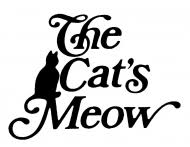Happy Holidays!
The Cat’s Meow is by Bo Bandy, and I’m excited about it being this week’s Storytime Saturday selection because of its point, and because of how it moves to its revelation through interviews that build to a great final line. Anyone who didn’t mind sitting down to old-school episodes of the Twilight Zone should appreciate how this resolves, and this sure ends up a lot funnier!
I’ll be frank: there are some extra adjective and tag choices I think an aggressive editor would revisit, but in some places that specificity also adds to the character who’s speaking. As a cat owner myself, it’s ending also made me laugh, and I’ve thought about this short over quite a few meows since reading — yep, The Cat’s Meow is one of those.
(You can read more of Bo’s thoughtful stuff at mymindfudge.wordpress.com, and he’s pretty prolific! The site touts a generous 250 short stories, 400 poems, and counting.)

I asked the researcher I was interviewing what specifically he was trying to learn about domestic cat behavior. His reply was both clear and concise. It is always good when an interview subject offers natural responses on camera. Otherwise it becomes an editor’s difficult job to salvage the footage. They have to cut it in such a way that it doesn’t come across as awkward. Luckily my assignment was comfortable and engaging on film.
“As an animal behaviorist who specializes in studying our feline house companions, I seek to better understand what makes the little balls of fur tick. They are complex creatures. By studying their body language and various postures, we can learn a great deal about how to interpret their moods and future behavior. I also hope to decipher their complex range of vocalization. What are they ‘saying’ when they come up to our feet and purr or meow? What do they want us to know? I’d love to find out exactly what they are trying to tell us.”
“Very interesting.” I agreed off camera. “I think many cat owners have wondered that. Sure, we assume it’s coos of love and acceptance but it could be more complex and detailed than that. Finding out what they are trying to communicate with us would be very compelling! I hope you crack the feline code, sir. Do you have some scientific methods of deciphering what it might mean?” I asked. It was always good to prod the subject with follow up questions to keep them talking.
“Thank you. We hope to have some very definitive answers soon.” He replied. “We are mapping their brain activity with an MRI and monitoring which sections are the most active for different circumstances. From the specific activity we recognize like hunger, anger, lust, and fear; we will chart out a baseline. I expect that strong behavior patterns will materialize almost immediately. When they are stalking prey or courting a suitor for mating, we will see strong, uniform activity in the same areas of our different test subjects. Once this activity chart is fully mapped out, we can test them to see how they respond to new situations. From the proximity of the unknown brain activity to the known, we can associate them and get a rough ‘translation’ of emotions. It will be the closest we’ll ever come to having a ‘cat-to-human’ translator.”
“So ‘fear’ might reside in the same general brain area as ‘anger’ and thus you can infer they are very close in the mind of the domestic cat?” I concluded.
“Exactly! It’s not a perfect science but we can loosely associate the known with the unknown. I hope my research gives humanity a better understanding of how cats feel about certain things. We wouldn’t extract this data from a single individual test subject. We will correlate our findings between all our subjects and then overlay them for a stronger picture. It’s the only way to form a scientific picture of felis domesticus as a species.”
“Do you expect any surprises?” I asked him point blank. “I’d think any open-minded research study would have to come with a few revelations that didn’t fit in with the initial hypothesis.”
He smiled. “There may be a few. As you implied, good science is open minded. If we go in looking to only confirm what we expect, that’s all we will find. Real science wants to discover the truth; not validate what we already believe. I’ve already spent two years conducting the same brain mapping research on the big cat species of lions, tigers, and leopards. Once I’ve finished collecting this data on their smaller cousins, we can compare it to my earlier research. I can’t tell you how professionally exciting it will be for me to compare the results!”
I thanked the man and wished him well. We promised to check back with him in a few months to see where the research led. As a medium-sized town mobile news reporter, I never really knew where my assignments would take me. I wasn’t even sure my line producer would let me follow up on the story but a few months later I got the assignment. Frankly I’d forgotten all about it.
This time the research scientist leading the project seemed very different. He was almost withdrawn and ‘down’. He’d been so animated and enthusiastic the first time that I almost dreaded conducting the follow up story. Subjects in that state of mind are among the most difficult to interview. I couldn’t help but assume the research had failed to go where he wanted it to. With that in mind, I jotted down a few questions to ask with a more sympathetic tone. When my camera man was ready, I began the interview.
“A few months ago, I sat down with you as you were just starting to map the domestic cat’s brain with an MRI. If memory serves, you were going to compare and overlay your data with earlier compiled data on the brain activity of big African cats. How did that turn out?”
He started out a little slowly and I feared we might have to stop. His reluctance to delve into his findings was obvious. His response and body language implied all his research was a wasted effort. I was tempted to remind him of his earlier words about true science being the search for truth and not validation; but I knew that would bring the interview to a screeching halt. Instead, I decided to give him some space to tell us about his findings, no matter how professionally disappointing they might be. Eventually he opened up and confessed the reason for his somber mood.
“Yes, that is correct. We collected MRI activity data from the domestic cats in our study. By comparing the brain reactions of circumstances we already knew, to those we did not; our understanding grew immensely of how the test subjects felt about other things. It was very successful research and we learned amazing things about the thought processes of cats in general. Especially those of smaller domestic cats.”
I was perplexed at his morose tone in light of what he explained. It sounded like his research went very well but I had to express that in a more discreet tone for the interview. “Great!” I tried to infuse enthusiasm into the proceedings. “I can’t help but detect a slight level of hesitancy in your voice though. Were some of your research findings not what you expected?”
He looked up at me and pursed a slight smile of reluctance. “Mumm, well yes. My team and I did make some discoveries that we didn’t expect. Some of our data results are going to be highly controversial. I’m still not prepared for the backlash it will be met with. We checked and rechecked our data a dozen times. It’s absolutely correct but once this interview becomes public, there will be a huge furor among pet owners everywhere. The public isn’t ready for the truth.”
I was taken aback by his statement. I never expected him to suggest the research was itself successful but the results would cause controversy. That possibility never even occurred to me. Of course he peaked my curiosity about what the big secret was going to be. His research was about house cats, for heaven’s sake. Just how ‘controversial’ could it be?
I guess he saw the heavy skepticism telegraphed on my face. Surely he understood my doubt considering the circumstances. It sounded like an exaggerated level of build up. I adopted a more contrite expression as he went on to explain but it was I who was in for a shock. If anything he understated how controversial his research would be.
“We did a complete MRI work up of reactions to different situations the domestic cats were exposed to. As we expected, their brain activity was focused in the same areas, for the same situations. From the known areas of brain activity, we could extrapolate data about the unknown reactions and how close they are. I’m proud to say that we now have an unprecedented understanding of their emotional responses.”
I was confused. None of that was even remotely controversial but I could tell he was holding back ‘the big one’. Whatever it was. I motioned for him to continue. It looked like he needed another push.
“As we expected, there was very little difference between the brain activity of the massive cats of Africa and our diminutive pets around the house. After all, they share 99% of the same DNA, right? The same things that intrigue a huge jungle tiger, intrigues our cute house pets. The same goes for fear, anger, lust and the full gamut of emotions they experience. What really took us by surprise was the similarity in their motivations. The smaller Asian leopard often ‘talks’ to its prey. We have witnessed them ‘chattering’ in a soothing manner to disarm and relax their prey before they pounce.”
I nodded politely at his informative story. I still didn’t see what any of it had to do with all his heightened level of secrecy and apprehension. I still couldn’t understand his pained hesitancy. Then he finally lowered the hammer.
“I wanted to explain about the Asian leopard’s hunting method because it’s important for you to understand my next point. Those cute purrs and meows from our feline companions that we always assumed were just gentle cries of love, are actually predatory taunts. They are focused in the same part of the brain that is hyper active when the big cats are about to strike and kill. Even our beloved house cats see us as food! They just recognize the futility of attacking such a larger animal and play ‘nice’ while they bide their time. Make no mistake, they would kill us all if they could. Every single cat owner in the world would be stunned if they aware of how much their pets were thinking about killing them. The cat’s meow is about eating us.”
